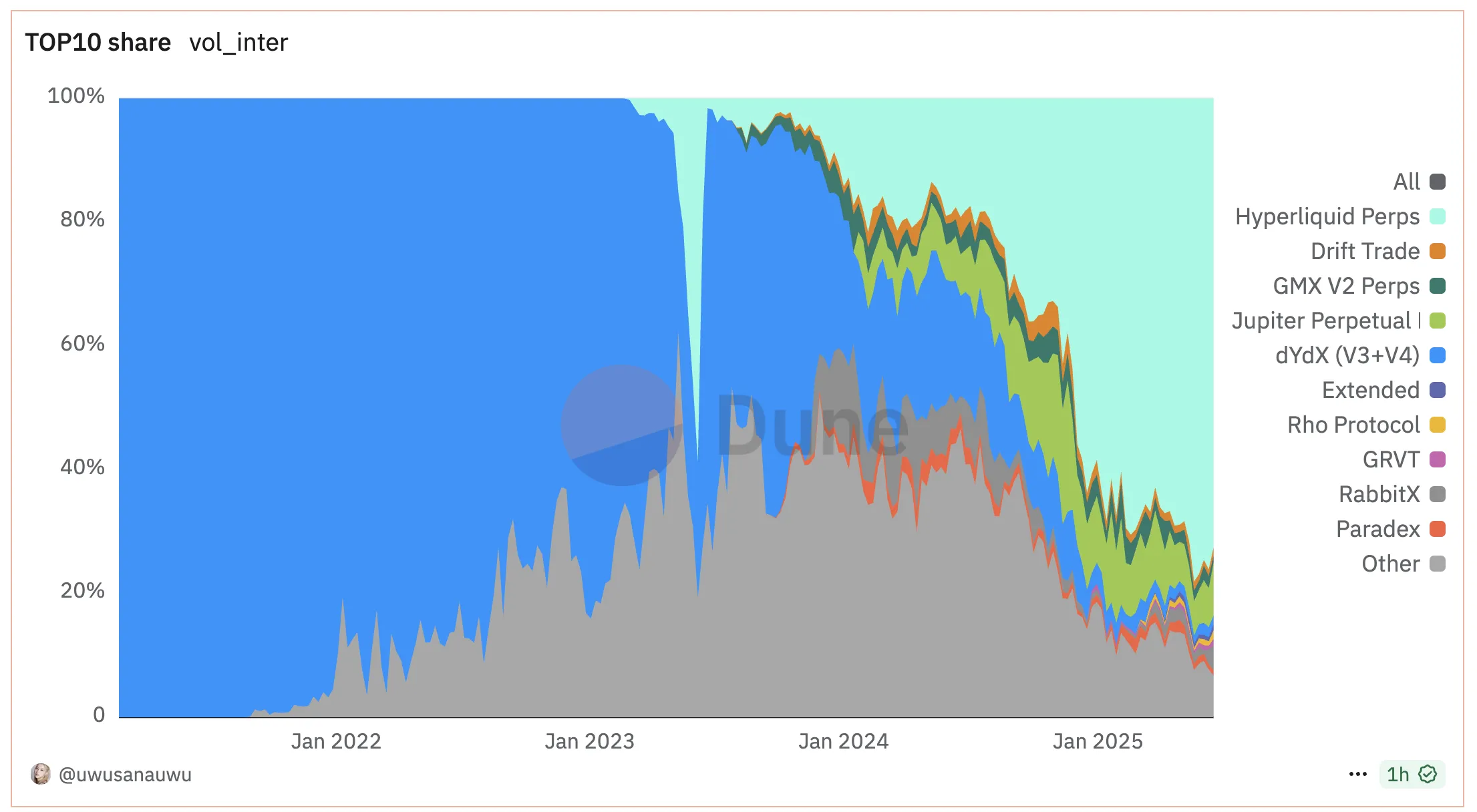| COINOTAG recommends • Exchange signup |
| 💹 Trade with pro tools |
| Fast execution, robust charts, clean risk controls. |
| 👉 Open account → |
| COINOTAG recommends • Exchange signup |
| 🚀 Smooth orders, clear control |
| Advanced order types and market depth in one view. |
| 👉 Create account → |
| COINOTAG recommends • Exchange signup |
| 📈 Clarity in volatile markets |
| Plan entries & exits, manage positions with discipline. |
| 👉 Sign up → |
| COINOTAG recommends • Exchange signup |
| ⚡ Speed, depth, reliability |
| Execute confidently when timing matters. |
| 👉 Open account → |
| COINOTAG recommends • Exchange signup |
| 🧭 A focused workflow for traders |
| Alerts, watchlists, and a repeatable process. |
| 👉 Get started → |
| COINOTAG recommends • Exchange signup |
| ✅ Data‑driven decisions |
| Focus on process—not noise. |
| 👉 Sign up → |
-
Hyperliquid, a leading decentralized perpetual futures exchange, reveals that only 14% of its traders are profitable, highlighting significant challenges in leveraged crypto trading.
-
A small elite group of traders has amassed over $10 million in profits, often leveraging substantial capital, while the majority face consistent daily losses averaging $5,600.
-
Despite these profitability disparities, Hyperliquid commands over 60% of the DeFi perpetual futures market, with a robust $188 billion in monthly trading volume.
Explore Hyperliquid’s trader profitability dynamics, market dominance, and the impact of leveraged trading on user outcomes in the decentralized finance space.
Analyzing Trader Profitability on Hyperliquid: A Closer Look at Market Realities
Recent data from Hyperdash underscores a stark reality for traders on Hyperliquid: only 135 out of 1,000 sampled traders have achieved profitability. This translates to a mere 14% success rate, with the average trader incurring a daily loss of approximately $5,600. Such figures reflect the inherent risks associated with leveraged perpetual futures trading, where amplified exposure can lead to significant financial setbacks for the majority of participants.
This trend is emblematic of the broader challenges faced by retail traders in high-leverage environments, where market volatility and rapid price movements often erode gains. The data suggests that while the platform offers lucrative opportunities, the majority of users must navigate a steep learning curve and risk management hurdles to achieve consistent profitability.
Top Earners and Capital Concentration: Insights from Industry Analysts
Crypto analyst DeFi Mochi, commenting on X (formerly Twitter), highlighted that only 170 traders on Hyperliquid have surpassed $10 million in profits, with 1,589 traders exceeding $1 million. These figures encompass both trading profits and rewards from platform airdrops. However, Mochi noted that many of these top earners exhibit a return on investment (ROI) below 200%, indicating that their success is often predicated on substantial initial capital rather than extraordinary trading skill alone.
| COINOTAG recommends • Professional traders group |
| 💎 Join a professional trading community |
| Work with senior traders, research‑backed setups, and risk‑first frameworks. |
| 👉 Join the group → |
| COINOTAG recommends • Professional traders group |
| 📊 Transparent performance, real process |
| Spot strategies with documented months of triple‑digit runs during strong trends; futures plans use defined R:R and sizing. |
| 👉 Get access → |
| COINOTAG recommends • Professional traders group |
| 🧭 Research → Plan → Execute |
| Daily levels, watchlists, and post‑trade reviews to build consistency. |
| 👉 Join now → |
| COINOTAG recommends • Professional traders group |
| 🛡️ Risk comes first |
| Sizing methods, invalidation rules, and R‑multiples baked into every plan. |
| 👉 Start today → |
| COINOTAG recommends • Professional traders group |
| 🧠 Learn the “why” behind each trade |
| Live breakdowns, playbooks, and framework‑first education. |
| 👉 Join the group → |
| COINOTAG recommends • Professional traders group |
| 🚀 Insider • APEX • INNER CIRCLE |
| Choose the depth you need—tools, coaching, and member rooms. |
| 👉 Explore tiers → |
This observation is supported by community commentary, with some users attributing large gains to favorable airdrops rather than pure market trading. Such capital concentration raises important questions about the accessibility and sustainability of profit distribution on decentralized trading platforms like Hyperliquid.

| COINOTAG recommends • Exchange signup |
| 📈 Clear interface, precise orders |
| Sharp entries & exits with actionable alerts. |
| 👉 Create free account → |
| COINOTAG recommends • Exchange signup |
| 🧠 Smarter tools. Better decisions. |
| Depth analytics and risk features in one view. |
| 👉 Sign up → |
| COINOTAG recommends • Exchange signup |
| 🎯 Take control of entries & exits |
| Set alerts, define stops, execute consistently. |
| 👉 Open account → |
| COINOTAG recommends • Exchange signup |
| 🛠️ From idea to execution |
| Turn setups into plans with practical order types. |
| 👉 Join now → |
| COINOTAG recommends • Exchange signup |
| 📋 Trade your plan |
| Watchlists and routing that support focus. |
| 👉 Get started → |
| COINOTAG recommends • Exchange signup |
| 📊 Precision without the noise |
| Data‑first workflows for active traders. |
| 👉 Sign up → |
Hyperliquid Trader Profitability. Source: Hyperdash
Market Dominance and Trading Volume: Hyperliquid’s Position in DeFi Perpetual Futures
Despite the uneven profitability landscape, Hyperliquid maintains a commanding presence in the decentralized finance sector. According to recent reports from COINOTAG and data aggregated by Dune Analytics, Hyperliquid controls over 60% of the perpetual futures market share. This dominance is attributed to its hybrid decentralization model, which has successfully attracted investor capital and fostered user trust.
| COINOTAG recommends • Traders club |
| ⚡ Futures with discipline |
| Defined R:R, pre‑set invalidation, execution checklists. |
| 👉 Join the club → |
| COINOTAG recommends • Traders club |
| 🎯 Spot strategies that compound |
| Momentum & accumulation frameworks managed with clear risk. |
| 👉 Get access → |
| COINOTAG recommends • Traders club |
| 🏛️ APEX tier for serious traders |
| Deep dives, analyst Q&A, and accountability sprints. |
| 👉 Explore APEX → |
| COINOTAG recommends • Traders club |
| 📈 Real‑time market structure |
| Key levels, liquidity zones, and actionable context. |
| 👉 Join now → |
| COINOTAG recommends • Traders club |
| 🔔 Smart alerts, not noise |
| Context‑rich notifications tied to plans and risk—never hype. |
| 👉 Get access → |
| COINOTAG recommends • Traders club |
| 🤝 Peer review & coaching |
| Hands‑on feedback that sharpens execution and risk control. |
| 👉 Join the club → |
The platform’s user base exceeds 499,000, with an impressive $188 billion in trading volume processed over the past 30 days. This activity has generated $37.61 million in fees, underscoring Hyperliquid’s significant role in facilitating high-frequency, high-value trades within the DeFi ecosystem.

Hyperliquid Perps Market Share. Source: Dune
Implications for Traders and the DeFi Ecosystem
The disparity in trader profitability on Hyperliquid highlights the complex dynamics of decentralized leveraged trading. While the platform offers substantial opportunities, the data suggests that success is heavily skewed towards well-capitalized traders who can absorb risks and leverage positions effectively. For retail traders, this environment demands rigorous risk management strategies and a deep understanding of market mechanics.
| COINOTAG recommends • Exchange signup |
| 📈 Clear control for futures |
| Sizing, stops, and scenario planning tools. |
| 👉 Open futures account → |
| COINOTAG recommends • Exchange signup |
| 🧩 Structure your futures trades |
| Define entries & exits with advanced orders. |
| 👉 Sign up → |
| COINOTAG recommends • Exchange signup |
| 🛡️ Control volatility |
| Automate alerts and manage positions with discipline. |
| 👉 Get started → |
| COINOTAG recommends • Exchange signup |
| ⚙️ Execution you can rely on |
| Fast routing and meaningful depth insights. |
| 👉 Create account → |
| COINOTAG recommends • Exchange signup |
| 📒 Plan. Execute. Review. |
| Frameworks for consistent decision‑making. |
| 👉 Join now → |
| COINOTAG recommends • Exchange signup |
| 🧩 Choose clarity over complexity |
| Actionable, pro‑grade tools—no fluff. |
| 👉 Open account → |
Moreover, Hyperliquid’s market leadership and robust trading volumes indicate a strong demand for decentralized perpetual futures, signaling continued growth potential for the platform and the broader DeFi sector. Investors and traders alike should monitor evolving trends and platform developments to navigate this competitive landscape effectively.
Conclusion
In summary, Hyperliquid exemplifies both the opportunities and challenges inherent in decentralized leveraged trading. While only a small fraction of traders achieve profitability, the platform’s market dominance and substantial trading volumes reflect its critical role in the DeFi ecosystem. Moving forward, traders must balance ambition with caution, leveraging insights and capital prudently to succeed in this high-stakes environment.
| COINOTAG recommends • Members‑only research |
| 📌 Curated setups, clearly explained |
| Entry, invalidation, targets, and R:R defined before execution. |
| 👉 Get access → |
| COINOTAG recommends • Members‑only research |
| 🧠 Data‑led decision making |
| Technical + flow + context synthesized into actionable plans. |
| 👉 Join now → |
| COINOTAG recommends • Members‑only research |
| 🧱 Consistency over hype |
| Repeatable rules, realistic expectations, and a calmer mindset. |
| 👉 Get access → |
| COINOTAG recommends • Members‑only research |
| 🕒 Patience is an edge |
| Wait for confirmation and manage risk with checklists. |
| 👉 Join now → |
| COINOTAG recommends • Members‑only research |
| 💼 Professional mentorship |
| Guidance from seasoned traders and structured feedback loops. |
| 👉 Get access → |
| COINOTAG recommends • Members‑only research |
| 🧮 Track • Review • Improve |
| Documented PnL tracking and post‑mortems to accelerate learning. |
| 👉 Join now → |
| COINOTAG recommends • Members‑only research |
| 📌 Curated setups, clearly explained |
| Entry, invalidation, targets, and R:R defined before execution. |
| 👉 Get access → |
| COINOTAG recommends • Members‑only research |
| 🧠 Data‑led decision making |
| Technical + flow + context synthesized into actionable plans. |
| 👉 Join now → |
| COINOTAG recommends • Members‑only research |
| 🧱 Consistency over hype |
| Repeatable rules, realistic expectations, and a calmer mindset. |
| 👉 Get access → |
| COINOTAG recommends • Members‑only research |
| 🕒 Patience is an edge |
| Wait for confirmation and manage risk with checklists. |
| 👉 Join now → |
| COINOTAG recommends • Members‑only research |
| 💼 Professional mentorship |
| Guidance from seasoned traders and structured feedback loops. |
| 👉 Get access → |
| COINOTAG recommends • Members‑only research |
| 🧮 Track • Review • Improve |
| Documented PnL tracking and post‑mortems to accelerate learning. |
| 👉 Join now → |









